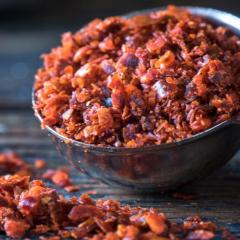Last night, I made polenta using a new technique and was quite pleased with the result. Over the years, I've tried several different techniques and a variety of cornmeal products, and I may have finally found a combination that works for me. The intent was to shorten the cooking time in the morning and make the resultant polenta softer and smoother.
For over a dozen years, Bob's Red Mill medium-grind organic cornmeal has been my (mostly) go-to product for muffins, cornbread, Johnny cakes, and porridge. I've also used it for polenta, but the results were not to my liking. My biggest complaint was that the polenta was a little too roughly textured, and some grains were not hydrated sufficiently. Those characteristics were fine for uses other than polenta, but I wanted the polenta to be a little smoother, softer, and “creamier.”
A few years ago I started using a corn muffin recipe that called for soaking the cornmeal in heated milk, and for several years I’ve been making steel-cut oats by soaking them overnight in water that had been boiled to shorten the cooking time in the morning.
Taking a cue from these techniques, I made last night's polenta by putting the cornmeal into a thick, heavy pot (to retain heat) and adding boiling water to it. The water:cornmeal ratio was 5:1 compared to my more usual 3 or 4 to 1 ratio. The mixture was stirred well to eliminate clumping, which was minimal, while the hob was turned on to keep the temperature up. Once the mixture came back up to boiling temp, the heat was turned off, the pot was covered, and left to sit on the now slowly cooling hob overnight for about six hours.
In the morning, the mixture was reheated and stirred for about 25 minutes to reach the desired texture, less than half the time it usually took to make polenta, The polenta still had some texture to it, but was soft throughout and had a creamier mouth feel compared to previous techniques.
Overall, the result was satisfying and quite close to the intended result ... almost exactly what I was looking for. When making it again, I may increase the water:cornmeal ratio slightly and/or increase the overnight soaking time. Shorter cooking time, better texture, more corn flavor than with other brands and techniques.


